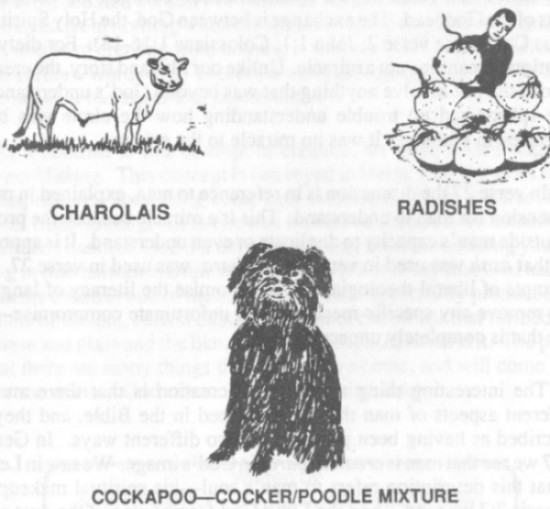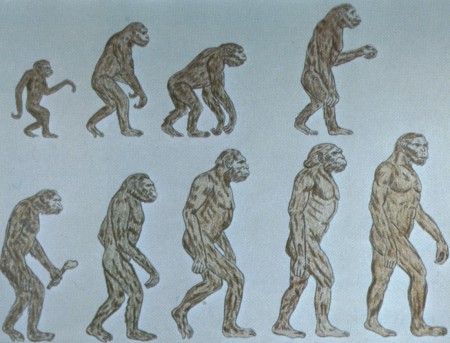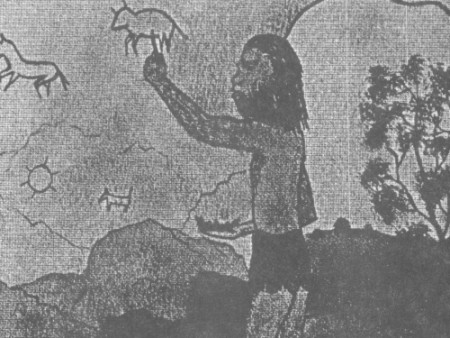
In previous lessons we have explored the nature of God and the nature of man as being created in God’s image. We have seen a model of why God would create man and have seen that there is a logical reason for our existence. The next question is a relatively unimportant one as far as our basic theme is concerned, because the existence of God is not dependent upon how He has accomplished His will. Perhaps a more vital question is the question of God’s creative technique in general.
The Hebrew concept of creation involves two different modes or means of bringing things into existence. One of these is the process of miraculous creation and is along the lines we discussed in Lesson 4. When we discussed the story of Flatland, we saw that in Flatland matter was created from nothing when the sphere touched the plane of Flatland. This process of creating from nothing is the concept normally indicated by the Hebrew word bara. This is the word used in Genesis 1:1 when the Bible says, In the beginning God created....
As a contrast to this concept of creation, we have what I will call Indirect Making. This concept is conveyed in Hebrew by the word asah and implies that something came into existence, not by a miraculous process from nothing, but rather was formed or shaped from something that already existed. God did not miraculously blast the building you are sitting in into existence from nothing. This is not to say that God had no role in the construction of the building because he certainly produced the calcium carbonate, silicon dioxide, and other chemicals that formed the concrete and glass and the like, and He created man to build it. The point is that there are many things that come, have come, and will come into existence without God miraculously producing them.
In Genesis 1 the word bara is used in verses 1,21, and 27. Things like matter, energy, life, and man’s soul seem to be the objects of these description. In the other verses, it would seem that we are being told that the process of God is one of making, molding, forming, and/or shaping things that have already been created. Some may object to this super- literal interpretation of bara and asah by responding that there are exceptions to the usages I have described in the previous paragraphs. Such a criticism is valid. In most manuscripts verse 26 of Genesis 1 says God made man in His image, and in verse 27 we are told God created man in his own image. Because of such an exception to the use of bara and asah one might suggest that no literalness of the kind that we are describing should be attempted. The fact of the matter is, however, that there are two different words, they do not ordinarily mean the same thing, and the nature of the Hebrew language is such that cases like this frequently occur. We answer such problems by the context and by careful consideration of what the author is attempting to convey. You will notice that verse 26 is a communication between the component parts of the Godhead. The exchange is between God, the Holy Spirit, and Jesus Christ (see verse 2; John 1:1; Colossians 1:16-18). For deity, the creation of man was not a miracle. Unlike our Flatland story, the creation of man did not involve anything that was beyond God’s understanding. The sphere had no trouble understanding how the circle was being produced in Flatland. It was no miracle to the sphere.
In verse 27 the discussion is in reference to man, explained in man’s dimension for man to understand. This is a miracle because the process is outside man’s capacity to duplicate or even understand. It is appropriate that asah was used in verse 26 and bara was used in verse 27. The attempts of liberal theologians to compromise the literacy of language and remove any specific meaning is an unfortunate compromise - and one that is completely unnecessary.
The interesting thing about man’s creation is that there are two different aspects of man that are described in the Bible, and they are described as having been produced in two different ways. In Genesis 1:27 we see that man is created (bara) in God’s image. We saw in Lesson 5 that this description refers to man’s soul—his spiritual makeup. In Genesis 2:7 we read, “And the LORD God formed man of the dust of the ground, and breathed into his nostrils the breath of life; and man became a living soul.” Obviously, this is in reference to man’s body - his physical makeup. Similar language is used in this chapter to describe the animals. God made man’s body from the materials that make up the ground, and we are told in other biblical references that our bodies will return to the ground from which it came. Man’s spiritual makeup is a miraculous act of God. God created man’s soul and that soul is eternal in nature.
How does evolution fit into this discussion? Obviously man’s spiritual makeup is not subject to physical laws, because the soul is not physical. Whatever application evolution might have in the discussion of man would have to be understood as dealing only with man’s physical makeup. Perhaps we, first of all, need to define what the word evolution means. Evolution refers to an unfolding type of change. It is not a dirty word or an evil concept. Evolution is a fact. Things do change! You are evolving from an infant to a mature adult. Your city is evolving in many ways. Even in a biological sense - things do evolve. Below are three pictures of newly evolved forms of life.

In man’s case it is obvious that change has taken place. If Eve is in fact the mother of all living, as Genesis 3 says and as genetic research confirms, all races of men on the earth must be her descendents. The fact that all mankind is one species and has not mutated so that there are multiple species of mankind is a supporting evidence of our common origin. Black men, white men, Orientals, Polynesians, and the like all came from Mother Eve. That means that Eve must have carried the genetic potential to produce all these races. As people migrated to equatorial areas of the earth, the possession of dark skin, black eyes, and a variety of other characteristics associated with black races offered advantages to survival in the climatic conditions present. Migrations to northern latitudes favored light skin, blue eyes, blonde features, and a variety of other characteristics which favored survival in colder conditions. Once again, this is evolution. God has made (asah) the races so that survival can be obtained on a changing earth.
How much change like this can occur? To what extent has man changed? There are those who suggest that such change can progress to such an extent that ultimately our ancestry can mechanically be traced back to an accidentally produced single-celled organism. We will explore that suggestion in later lessons. Some would agree with that assessment, but would suggest that God used or controlled the process. This is called theistic or mitigated evolution. Some would say that God created Adam and Eve as we are today and that the changes that have taken place have only been within the family of man. There are other views ranging from creation by aliens to a denial of any change at all.
What do you think? We are not going to embark on an anthropological debate in this lesson. To do so would require reprinting the lesson every week, because new discoveries are made at comparable rates. The important thing is to realize that what separates man from other living things is not his body or his chemistry! What makes man different is his spiritual makeup. Can you visualize how a spiritual creation is accomplished? Of course not, because it is not a part of our three dimensional world. Can you visualize how God could have made man’s body? Of course you can, because our bodies are three dimensional and operate in familiar conditions. One explanation of man’s being made is seen in the following illustration.

We have seen that God created man in His image and made man’s body of the dust of the earth. What was this first man like? Was he a caveman? What is a caveman? It is a man who lives in a cave!! If you can find someone who is willing to live in a cave, you can see a caveman today! This does not mean that the first man (Adam) and the first woman (Eve) were stupid! Paintings in caves like the one below indicate great skill and intelligence by the artist that drew them. It is true that these first people had little knowledge. There were no books or schools or television to convey the knowledge and discovery of others, so all learning was accomplished by those first men themselves. What these ancient people were able to do was incredible, and how rapidly they developed in their ability to control their environment is remarkable. Anyone who has seen the remains of the Inca, Mayan, Chinese, or Egyptian cultures has to be impressed with their ability and intelligence!

When we cut through tradition and bad science, what we find is that the biblical account is not a fairy tale full of myths. We do not have all the answers about everything that was done to make man the unique being that he is, but what is known is logical and consistent.